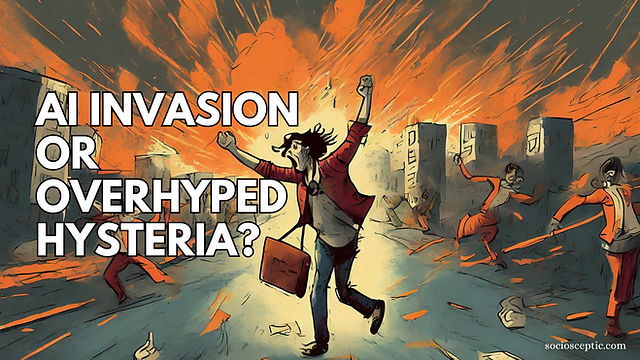Artificial intelligence has transcended from sci-fi to play an integral role in shaping our world. It’s not just a buzzword; it’s the driving force behind innovation in various sectors, promising to redefine our interaction with technology. But is the AI revolution overhyped, or does it truly hold the revolutionary potential we often hear about? This contemplation is critical as it can set the stage for realistic expectations, substantial investments, and ethical considerations in AI development.
Table of Contents
Is AI Revolution Overhyped?
We stand at the confluence of human intelligence and machine learning, where innovations in speech recognition, natural language processing, and image identification have revolutionized how we think about software’s capabilities. AI’s potential is vast, from medical diagnostics to personalized marketing. But it’s crucial to discern between genuine breakthroughs and exaggerated claims fueling the AI hype.
In this exploration, we will chart the variables that construct the AI hype, examine the underlying principles of the technology, and evaluate its far-reaching effects on global economies, human labor, and ethical landscapes. We aim not to discredit AI’s potential but to provide a clear, unembellished view of its evolution.
Defining Hype in AI

Understanding the nature of hype is vital to our exploration. Hype can be defined as an excessive or exaggerated promotion of a particular idea or technology. In AI, this might manifest as claims that AI systems can perform tasks beyond their current capabilities.
But here’s the paradox: Hype, though sometimes misleading, can also pave the way for genuine advancements. By raising expectations and funding, the tech industry often pushes itself toward fulfilling the prophecies it creates. We saw this in the development of the internet, and we’re witnessing it again in AI.
Factors Contributing to AI Hype
The roots of AI hype go deep, stemming from how it is portrayed in media, the expectations of various industries, and the public’s perceptions. These factors often feed into each other, creating a feedback loop of anticipation and awe.
If you’ve read a headline in the past decade, it likely contained a superlative about AI’s prowess. Whether beating world champions at games or driving cars without human intervention, the media significantly amplifies AI achievements and potential.
Industries across the spectrum eagerly anticipate AI’s disruptive power to enhance productivity, automate mundane tasks, and unlock unimaginable insights into consumer behavior and market trends. This readiness to adopt AI can be both a driver and a casualty of inflated expectations.
The buzz around AI has instilled a mix of wonder and fear in the public consciousness. From expectations of AI personal assistants to concerns over job displacement, the narrative is laden with potential utopias and dystopias, contributing to the technology’s mystique.
Real-world AI Applications
To ground our understanding, we need to glance beyond the hype and into the tangible ways AI makes a difference. From AI-driven chatbots providing customer service to machine learning algorithms identifying patterns for disease treatments, AI’s real-world impact is undeniable.
IBM’s Watson, for example, has made remarkable strides in diagnosing cancers, while Google’s language translation algorithms bring a babel fish of sorts to the masses. These systems and others like them are not just experimental; they are becoming essential tools in their respective fields.
The ripples of AI are reshaping industries, with automation and data-driven insights at the forefront. In manufacturing, AI is optimizing production lines. In finance, it is powering complex risk analysis models. In entertainment, recommendation systems influence what we watch and listen to.
Challenges and Limitations
As with any technology, AI is not without its hurdles. There are ethical considerations about AI systems’ decisions, technical limitations that still need to be overcome, and persistent issues surrounding privacy and bias in AI algorithms.
AI’s decision-making capabilities raise questions about accountability and the values embedded in algorithm design. For example, should an AI system prioritize one life over another in a medical emergency, and who is responsible for that decision?
As advanced as AI systems are, they’re far from sentient. Current AI lacks human-like common sense and can’t operate beyond the specific parameters it was designed for. True artificial general intelligence, which could replicate human cognition across various tasks, remains a far-off goal.
AI’s power is drawn from data, and that data often carries the implicit biases and privacy concerns of its human origins. AI’s reliance on data poses significant ethical and societal challenges, from racial biases in facial recognition to worries over data misuse.
We need to look ahead to understand if the AI revolution is overhyped. Expert opinions and forecasts can help us anticipate where AI is headed and what breakthroughs might be on the horizon.
Expert Opinions and Forecasts
Some experts predict that AI’s current trajectory will soon lead to systems capable of outperforming humans in an increasing array of tasks. Other forecasts are more conservative, projecting that AI will continue to be a tool that complements human intelligence rather than replaces it.
The next major breakthrough in AI might come in the form of a system that truly understands and learns from its experiences, opening the door to new heights of automation and analysis. Or, it could be a quantum leap in energy efficiency, unlocking the computational power required for AGI.
Conclusion: In Pursuit of an Informed AI Future
In wrapping up our inquiry, it’s evident that the AI revolution is a nuanced tale of awe-inspiring capabilities, apprehensive questions, and measured strides forward. Hype is both a driving force and a potential roadblock, echoing throughout AI’s narrative from its inception.
However, the conversation about AI continues after this assessment. It is ongoing, dynamic, and intertwined with the very fabric of human progress. To harness AI’s potential while mitigating its pitfalls, we must adopt a stance of informed enthusiasm that recognizes the technology’s current and imminent achievements while retaining a keen awareness of its boundaries.
With such a balanced approach, we can cultivate an AI revolution that is neither overhyped nor underestimated but realized to its fullest and most beneficial extent.
Resources:


